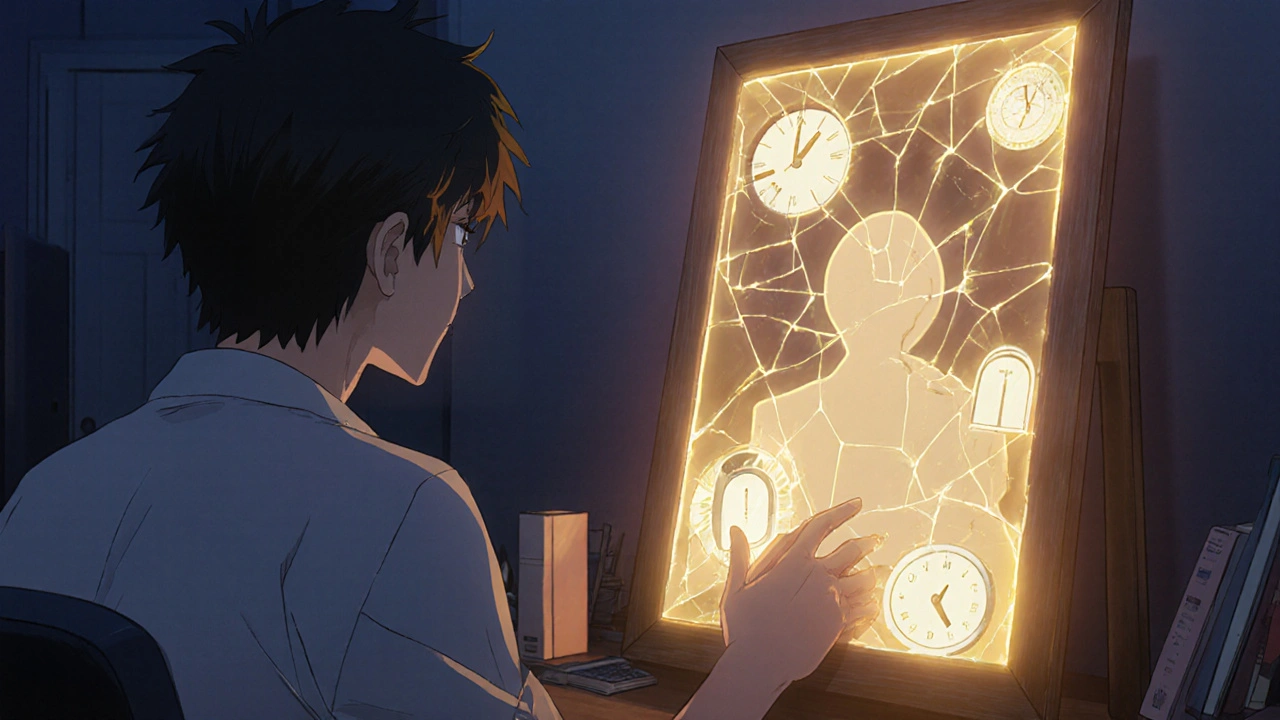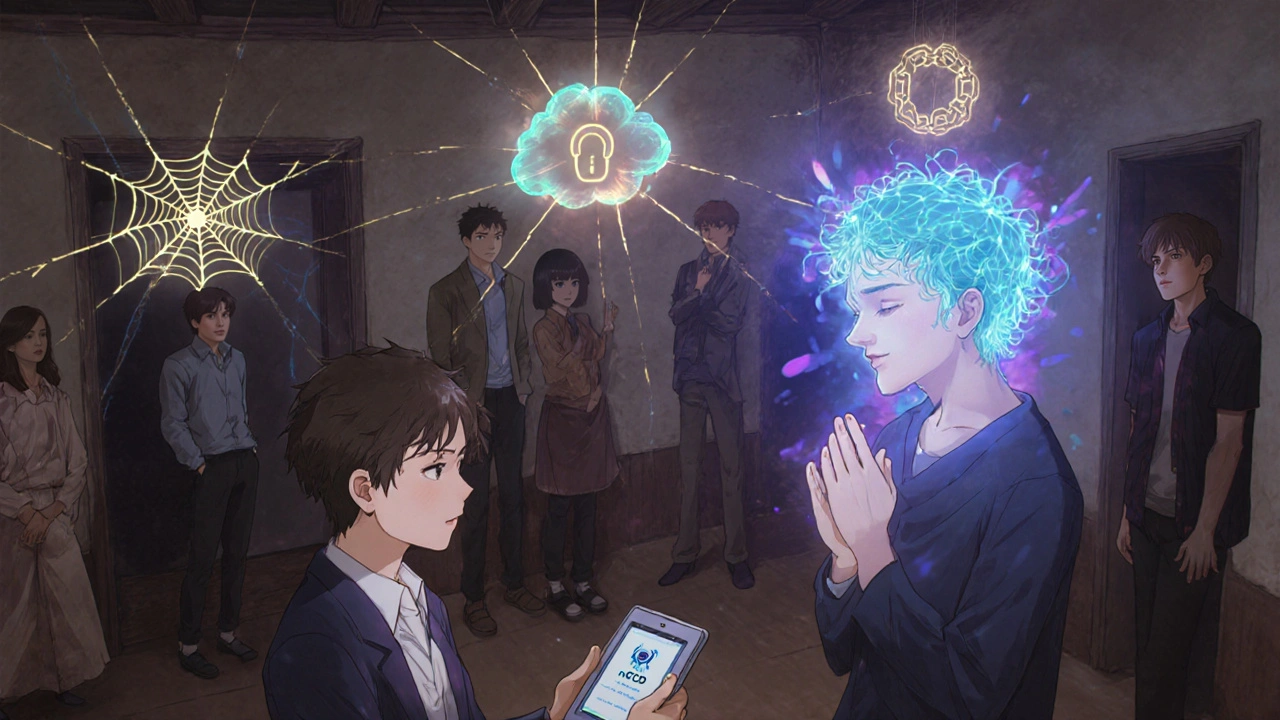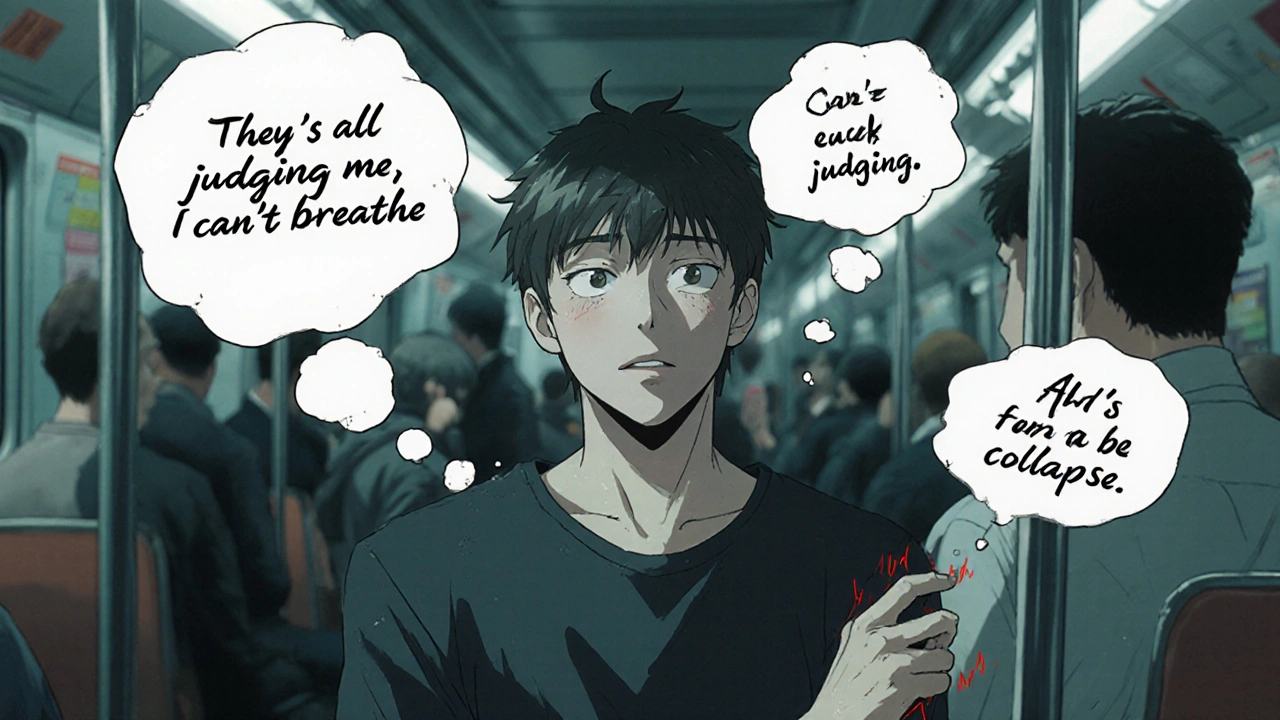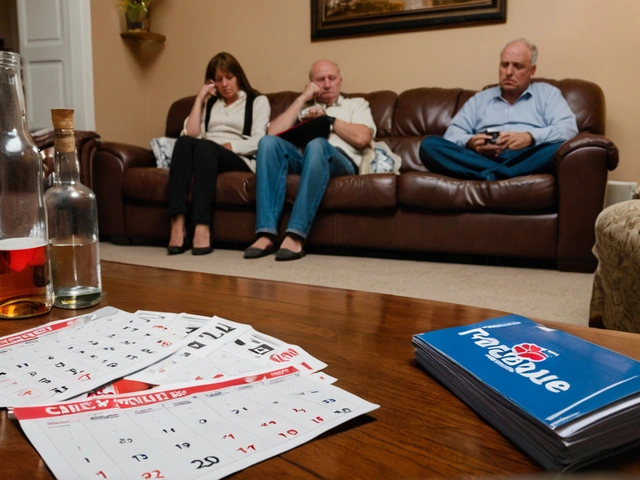More than 1 in 5 adults in the U.S. deals with an anxiety disorder every year. It’s not just feeling stressed or nervous-it’s persistent, overwhelming fear that messes with sleep, work, relationships, and even breathing. If you’ve ever had a panic attack in the middle of a grocery store, avoided social events because you feared judgment, or spent hours replaying a conversation in your head, you’re not alone. And the good news? We know what works.
What Are the Main Types of Anxiety Disorders?
Anxiety isn’t one thing. It shows up in different forms, each with its own pattern. The DSM-5, the standard guide doctors use to diagnose mental health conditions, lists seven main types. Some are common, others less known-but all are real and treatable.Generalized Anxiety Disorder (GAD) means constant, excessive worry about everyday things-work, bills, health, even minor decisions. It’s not just being cautious; it’s racing thoughts, muscle tension, and fatigue that last six months or longer. About 3.1% of U.S. adults live with GAD, and women are more likely to be affected.
Panic Disorder hits with sudden, intense surges of fear. These panic attacks come out of nowhere and include symptoms like a pounding heart, chest pain, dizziness, and the feeling you’re dying or losing control. After one attack, many people live in fear of the next, which can lead to avoiding places or situations altogether.
Social Anxiety Disorder isn’t just shyness. It’s a deep fear of being watched, judged, or humiliated. This can mean skipping parties, avoiding eye contact, or even refusing to speak in meetings. It affects 7.1% of adults and often starts in the teen years.
Specific Phobias are intense fears of particular things-spiders, heights, flying, needles. The fear is out of proportion to the actual danger. Around 8.7% of adults have at least one specific phobia, and many go years without seeking help because they can just avoid the trigger.
Separation Anxiety Disorder used to be seen as a childhood issue, but it’s now recognized in adults too. People with this condition feel extreme distress when separated from loved ones-even if they’re safe. It’s not just missing someone; it’s constant worry that something terrible will happen to them.
Obsessive-Compulsive Disorder (OCD) involves intrusive thoughts (obsessions) and repetitive behaviors (compulsions) meant to reduce anxiety. It’s not just liking things neat-it’s spending hours washing hands, checking locks, or mentally repeating phrases to neutralize fear. OCD affects 1.2% of U.S. adults.
Selective Mutism mostly affects children who can speak normally at home but stay silent in school or social settings. It’s not defiance or shyness-it’s an anxiety-driven freeze response. Without treatment, it can interfere with learning and social development.
What Do the Symptoms Actually Look Like?
Symptoms vary by type, but many share common physical and mental signs. You might not even realize your racing heart or nausea is anxiety.Physically, people report:
- Heart rate spikes to 110-140 beats per minute during panic attacks
- Sweating (92% of panic disorder patients)
- Trembling or shaking (87%)
- Shortness of breath (83%)
- Dizziness or lightheadedness (76%)
- Nausea or stomach upset (68%)
Cognitively, the mind gets stuck in loops:
- Difficulty concentrating (89% of GAD cases)
- Racing thoughts that won’t stop (82%)
- Catastrophic thinking-imagining the worst-case scenario as inevitable (76%)
- Rumination-replaying events over and over, searching for mistakes (91%)
Emotionally, people describe:
- Feeling like doom is about to hit (95% during panic attacks)
- Worry that’s way out of sync with reality (100% in GAD)
- Fear of losing control or going crazy (88%)
These aren’t just "bad days." They’re persistent, disabling, and often misunderstood. Many people think they’re just "overreacting," but the brain’s threat system is stuck in overdrive.
What Treatments Actually Work?
The most effective treatments for anxiety aren’t guesswork-they’re backed by decades of research. Two approaches stand out: therapy and medication.Cognitive Behavioral Therapy (CBT) is the gold standard. It’s not talking about your past-it’s learning skills to change how you think and act in the moment. A key part is exposure: gradually facing feared situations in a controlled way. For example, someone with social anxiety might start by saying hello to a cashier, then move to asking a question in a group. Studies show 50-60% of people see major symptom reduction after 12-20 weekly sessions. Dr. Anne Marie Albano from Columbia University says exposure therapy works for 60-80% of people with phobias and social anxiety when done right.
Medication helps too, especially when symptoms are severe. SSRIs like sertraline (Zoloft) and fluoxetine (Prozac) are first-line choices. They don’t work overnight-it takes 6-12 weeks-but they reduce anxiety by balancing brain chemicals. Around 40-60% of people respond well. SNRIs like venlafaxine are similar in effectiveness. Both are safer long-term than benzodiazepines, which can be addictive and cause memory issues with prolonged use.
Other options include buspirone, a non-addictive anti-anxiety drug, and newer treatments like zuranolone (Zurzuvae), approved in 2023 for postpartum anxiety, with a 54% remission rate in trials. Acceptance and Commitment Therapy (ACT) is now also recommended as a first-line option by the American Psychological Association. It focuses on accepting anxious thoughts instead of fighting them, while still taking action toward meaningful goals.

What About Digital Tools and Apps?
Technology is filling gaps in care. FDA-cleared apps like nOCD and Wysa guide users through CBT exercises, breathing techniques, and exposure logs. In 8-week studies, users saw 35-45% symptom reduction with just 20-30 minutes a day. These aren’t replacements for therapy, but they help people stay consistent between sessions.Some apps even use AI to predict panic attacks. Stanford research in 2023 showed AI could forecast attacks 24 hours in advance with 87% accuracy by analyzing voice patterns, movement, and sleep data. While still emerging, this could one day trigger early interventions.
Medicare now covers two CBT-based digital platforms, reimbursing $120-$180 per module. This is a big step toward making evidence-based care more accessible.
Why Do So Many People Still Struggle?
Even though we have effective tools, many people don’t get help-or don’t stick with it.A 2022 VA survey found only 37% of anxiety patients achieved remission after six months. Why? Two big reasons: access and dropout.
Wait times for specialized therapists can be 6-8 weeks. Insurance often limits sessions. And CBT isn’t easy-it’s hard to face your fears. One Reddit user wrote: "CBT helped, but exposure exercises made me want to quit." That’s normal. Temporary worsening is part of the process. 75% of people feel worse before they feel better.
Medication side effects also turn people away. Some report emotional numbness, weight gain, or sexual dysfunction. One user switched from an SSRI to buspirone and felt more like themselves. Finding the right fit takes patience.
But here’s the truth: combining therapy and medication works best. A 2023 NAMI survey showed 58% of people improved with both, compared to 42% with meds alone and 38% with therapy alone.

What’s Next in Anxiety Treatment?
The field is moving fast. In 2023, researchers identified three distinct "anxiety biotypes" using brain scans. Each responds differently to treatment-meaning future care could be personalized based on your brain activity, not just your symptoms.Ketamine-assisted therapy is showing promise for treatment-resistant anxiety, with 65% of patients reporting rapid relief in 2022 trials. Genetic testing is also on the horizon. Dr. Kerry Ressler predicts that within five years, we’ll use DNA to pick the best medication, cutting out trial-and-error.
And stigma is dropping. In 2010, only 42% of Americans saw anxiety as a medical condition. Now, 67% do. That shift is helping more people reach out.
There’s no magic cure. But we know what helps. Whether it’s CBT, medication, digital tools, or a mix-recovery isn’t about eliminating anxiety completely. It’s about learning to live with it without letting it run your life.
Can anxiety disorders go away on their own?
Sometimes symptoms ease over time, but anxiety disorders rarely disappear without treatment. Left untreated, they often get worse or lead to other problems like depression, substance use, or social isolation. Early intervention gives you the best chance at long-term recovery.
Is CBT better than medication for anxiety?
CBT and medication work differently. CBT teaches skills that last after treatment ends, while medication reduces symptoms while you’re taking it. Studies show CBT has slightly higher long-term success rates. But for severe cases, combining both gives the best results. There’s no one-size-fits-all answer-it depends on your symptoms, preferences, and access to care.
How long does it take for SSRIs to work?
SSRIs usually take 6 to 12 weeks to show full effects. Some people notice small improvements in sleep or energy within 2-4 weeks, but reduced anxiety takes longer. It’s important to stick with the medication, even if you don’t feel better right away. Your doctor may adjust the dose if needed.
Can kids have anxiety disorders too?
Yes. Half of all anxiety disorders begin by age 11. In children, symptoms may look different-like tantrums, clinginess, or refusing to go to school. Selective mutism and separation anxiety are common in kids. Early treatment with CBT adapted for children is highly effective and can prevent lifelong struggles.
What if I can’t afford therapy?
There are low-cost options. Many community health centers offer sliding-scale fees. Online platforms like Open Path Collective connect people with therapists charging $30-$60 per session. Free or low-cost CBT apps like Woebot and nOCD can help build skills. Support groups through NAMI and ADAA are also free and available nationwide.
Are natural remedies like CBD or supplements helpful?
Some people report relief from CBD, magnesium, or ashwagandha, but the science is limited. Unlike CBT or SSRIs, these aren’t proven to treat anxiety disorders on their own. They might help with mild stress, but shouldn’t replace evidence-based treatment. Always talk to your doctor before trying supplements-they can interact with medications.
How do I know if I need professional help?
If anxiety is keeping you from doing things you used to enjoy, making you avoid people or places, or causing physical symptoms like chest pain or insomnia, it’s time to talk to a professional. You don’t need to be "broken" to seek help. If it’s affecting your life, it’s worth addressing.
What Can You Do Right Now?
Start small. If you’re overwhelmed, try one thing: practice diaphragmatic breathing. Breathe in slowly through your nose for 5 seconds, hold for 2, then out through your mouth for 6 seconds. Do this for 2 minutes. It lowers your heart rate and signals your brain it’s safe.Look up a free CBT worksheet online. Write down one anxious thought and challenge it: "What’s the evidence this will happen? What’s a more realistic outcome?"
Call NAMI’s helpline at 1-800-950-NAMI. They’ll connect you with local resources, support groups, or low-cost providers.
Anxiety doesn’t have to be your life sentence. You don’t need to fix everything at once. Just take one step. The tools are here. You just need to reach for them.


![Buy Cheap Generic Cialis (Tadalafil) Online UK: Safe Options, Prices & Risks [2025]](/uploads/2025/08/thumbnail-buy-cheap-generic-cialis-tadalafil-online-uk-safe-options-prices-risks.webp)





Kane Ren November 23, 2025
Just wanted to say this post gave me hope. I’ve been stuck in my head for years, thinking I was just "weak," but reading this made me realize it’s biology, not character. I started CBT last month and yeah, it’s hard-but I’m finally sleeping again. You’re not broken. You’re just wired differently. Keep going.
Charmaine Barcelon November 24, 2025
You people are so dramatic! It’s just anxiety! Stop making it a medical condition! I used to have panic attacks too-then I just told myself to stop being a baby. Now I’m fine. Why can’t you all just toughen up?!?!?!?!
Karla Morales November 25, 2025
While I appreciate the clinical depth of this post, I must note that the statistical framing lacks contextualization regarding socioeconomic stratification in treatment access. Furthermore, the emphasis on pharmaceutical interventions may inadvertently reinforce biomedical hegemony over psychosocial determinants. 📊💊
Additionally, the omission of cultural variations in somatic expression of anxiety (e.g., somatization in collectivist societies) is a critical oversight. 🤔
Javier Rain November 25, 2025
Listen. I was in the exact same place two years ago. Couldn’t leave the house. Thought I was dying every time my heart beat too fast. Then I did one exposure a day. Started with opening the front door. Then walking to the mailbox. Then saying hi to the neighbor. Now I give presentations at work. It’s not magic. It’s repetition. You don’t need to be brave-you just need to show up. Even if you’re shaking. Even if you cry. Show up anyway. You got this.
Laurie Sala November 27, 2025
I’ve been on 3 different SSRIs… and each time, I felt like a zombie… like my emotions were turned down to 5%… and I just… I just miss feeling… anything real… I cried for three days after I stopped Prozac… and then I felt… nothing… and that was worse… I don’t know what to do anymore… 😭😭😭
Lisa Detanna November 27, 2025
As someone raised in a culture where mental health was never spoken of, this post felt like a lifeline. In my family, anxiety was "weakness," depression was "sin," and therapy was "for crazy people." I’m 34 and just started CBT last year. It’s not easy to unlearn generations of silence-but it’s worth it. To anyone reading this from a similar background: your pain is valid. You deserve help. Even if no one else says it.
Demi-Louise Brown November 29, 2025
Diaphragmatic breathing works. I use it before meetings. Inhale 5, hold 2, exhale 6. Do it three times. It resets your nervous system. No apps needed. No pills. Just breath. Start small. One minute a day. That’s all it takes to begin.
Matthew Mahar November 29, 2025
OMG I JUST REALIZED I’VE BEEN RUMINATING ON THAT ONE EMAIL FROM 2018 FOR SIX YEARS 😭 I’M NOT OKAY I NEED TO CALL MY THERAPIST NOW I’M GOING TO DO IT RIGHT NOW I’M GOING TO DO IT
John Mackaill November 29, 2025
For anyone feeling overwhelmed by the idea of therapy: you don’t need to find the perfect clinician right away. Start with a single session. Even if it’s not a perfect fit, it’s a data point. I tried five therapists before I found mine. The fifth one asked me what I wanted to change-not what was wrong with me. That changed everything.
Adrian Rios December 1, 2025
I’ve spent the last decade reading everything I could find on anxiety-neuroscience papers, memoirs, clinical trials, Reddit threads, even ancient Buddhist texts. And here’s what I’ve learned: anxiety isn’t your enemy. It’s a misfired alarm system. It’s trying to protect you from something that isn’t there. The goal isn’t to silence it. It’s to learn its language. To say, "I hear you, but I’m safe now." CBT teaches you that. Medication helps you hear it clearly. And community? That’s the part no one talks about enough. You’re not alone in this. I’ve been there. I’m still here. And I’m not giving up. Neither should you.
Casper van Hoof December 3, 2025
The ontological paradox of anxiety lies not in its phenomenological intensity, but in its epistemological ambiguity: if the mind constructs reality through interpretive frameworks, and anxiety arises from perceived threats within those frameworks, then is anxiety not merely a recursive epistemic loop? The therapeutic imperative, then, is not to eliminate anxiety, but to destabilize its epistemic authority. In this light, CBT functions as a hermeneutic recalibration tool-replacing catastrophic narratives with probabilistic ones. The pharmaceutical intervention, by contrast, operates at the level of neurochemical substrate, attempting to mute the signal rather than reinterpret its meaning. Both are valid. Neither is sufficient alone.
Pramod Kumar December 5, 2025
Bro, I came from a village in India where people said "anxiety" was just "too much thinking." I got my first panic attack on a bus in Delhi. No one knew what to do. I thought I was cursed. Then I moved to the U.S., found a therapist who spoke Hindi, and she said, "Your mind is loud, not broken." That changed everything. Now I use breathwork, write in my journal in Hindi, and teach my cousins to breathe before exams. You’re not alone. We’re all just trying to quiet the noise inside. And it’s okay if it takes time. I’m still learning. So are you.